ABRSM’s Grade 5 music theory exam is perhaps one of the most popular theory courses to study. In this post I will focus on what the ABRSM grade 5 theory exam entails and how you can go about learning all the requirements and guarantee not only achieving a pass but aiming for a much higher score!
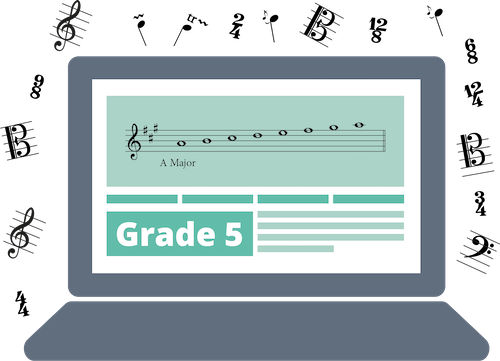
how has the Exam changed?
The theory exams have constantly evolved over the years, but recently ABRSM updated the requirements for their music theory exam in a more extreme way. This was in response to the recent Covid-19 Pandemic where we all had to go online! Historically, Grade 5 music theory was taken in an exam hall as any traditional exam would be taken! However, with the need to socially distance to prevent the spread of covid-19 ABRSM designed the exam to be taken online instead!
In response to this, the syllabus needed to be changed slightly. Questions within the paper now need to be suited more to online questions, meaning that there are no questions where you need to draw out things but a bigger focus on multiple choice questions. But do not be fooled, this exam is by no means any easier! It is important to note that any composition aspect of this exam has also been removed although this happened a while ago now!
Want to practise the exam, download a free Grade 5 exam paper here.
Why Is Grade 5 Music theory Important?
ABRSM Grade 5 Music Theory is an important exam for two reasons. Firstly, it is needed before you can take Grade 6 and above practical exams. Secondly, many university courses require it, not only for classical programmes but for pop, contemporary and jazz. The exam is also quite popular with over 20,000 pupils taking it each year, mostly in the UK and South and East Asia.
Although Grade 5 does not give you any UCAS points, can see set you on the road to taking Grade 6-8 Theory. At this level you can earn UCAS points for achieving these qualifications. So music theory can even help you get into university!
What is the syllabus for ABRSM Grade 5 music theory?
The new syllabus is now broken up into nine distinct sections within the ABRSM grade 5 music theory:
- Rhythm – Time Signatures
- Pitch – Clefs
- Pitch – Transposition
- Scale and Key Signatures
- Intervals
- Chords
- Terms, Signs and Instruments: Instruments of the Orchestra
- Terms, Signs and Instruments: Ornamentation
- Music in Context
We will look at each of these sections in more detail now. By the end of this post you will understand what each topic entails.
Rhythm– Time Signatures
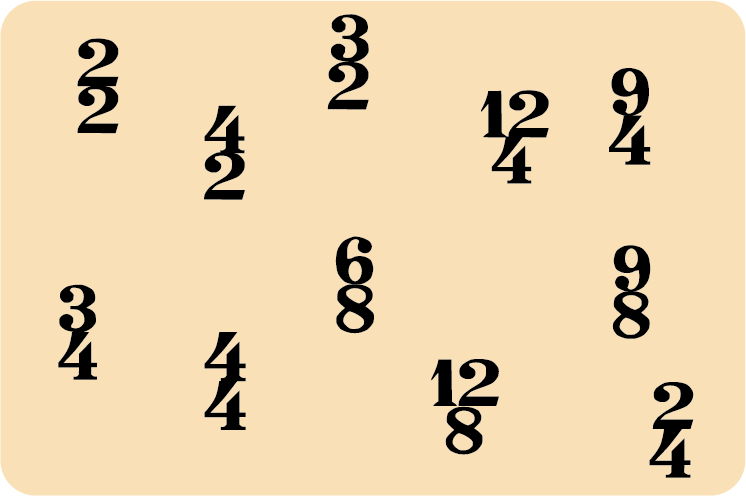
Within this rhythm section you need to make sure you understand different types of music notation and how this is ordered within music. Specifically you need to understand:
- Time signatures, in particular the difference between simple and compound time signatures. This is something that is explained in the earlier abrsm music theory grades but it is worth noting again here because it welcome upon the theory exams.
- Irregular time signatures – this refers to 5/4, 5/8, 7/4 and 7/8. This is new for grade 5 music theory specifically so make sure you study this carefully.
- You should also be able to group your notes correctly in all three different types of times signatures: Simple, Compound and Irregular.
- Slightly different and even more specific to rhythm: as well as understanding duplets and triplets, which you learnt earlier in your music theory studies. The grade 5 music theory syllabus adds quintuplets and sextuplets
More information on Grade 5 time Signatures here.
Pitch – Clefs

In the grade 5 music theory syllabus we divide the pitch section into two parts. This first part of pitch includes:
- Understanding the clefs treble, bass and alto, as well as the placement of middle C
- Being able to use the new clef – tenor clef
- Be able to move between all four of these clefs without changing the pitch. You should also be able to do octave transposition between these four clefs!
Pitch – Transposition
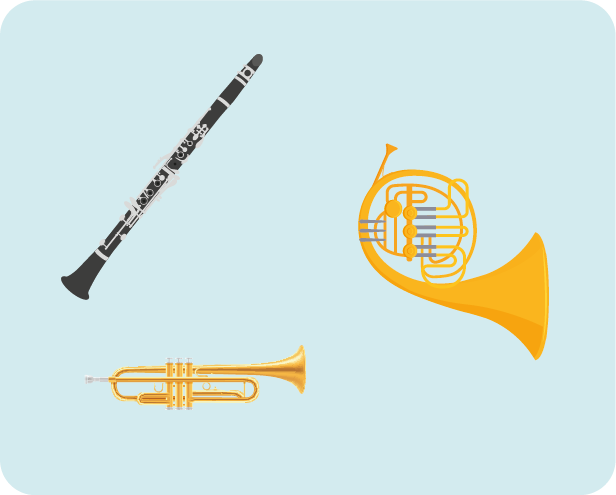
The second part of the pitch topic takes focuses on transposition. In the previous section you will look at octave transposition and moving between the different clefs but in this topic we will focus on more specific transposition. This includes:
- Transposing up and down a major second
- Transposing up and down a minor third
- Transposing up and down a perfect fifth
- Be able to transpose accidentals within a melody
- Understand what a transposing instrument is – including the trumpet in Bb, French horn in F and clarinet in A!
Scales and Key signatures

Further through the syllabus still, we land on keys and scales. Although this seems self explanatory it is worth writing down exactly what you should know for this section of the grade 5 music theory.
- Circle of fifths – this is one of the most useful tools in all of music theory and it doesn’t lose it’s importance when doing your grade 5 theory!
- You should know all of your major and minor keys and their key signatures!
- You should also be able to draw all the key signatures correctly and more specifically have your sharps and flats in the correct order.
- Understanding the circle of fifths helps you to really understand the four new scales needed for the Grade 5 exam: F# major, Gb major, D# minor and Eb minor. You should also have an understanding of the enharmonic relationship between these scales.
More information on Grade 5 Scales and Key Signatures here.
Intervals

Intervals is the next big topic you should understand clearly before taking your grade 5 theory exam. You will have seen this in earlier music theory exams but this will be expanded for the grade 5 course. This topic includes:
- You should understand what an interval is and how to label it, including the use of words major, minor and perfect. You should also be able to work these out whether they use a key signature or not and whether the interval is harmonic or melodic.
- You should Understand what chromatic intervals are and the labels augmented and diminished that go alongside these.
- You should Understand Compound intervals. Remember these intervals that are larger than an octave!
More information on Grade 5 Intervals here.
Chords and Cadences

Further through the syllabus, we land at chords/harmony. Throughout the music theory grades your knowledge of chords has built up, for grade 5 music theory here is what you should know about chords:
- The Chords I (tonic), IV (sub dominant) and V (dominant) in all keys!
- New to ABRSM Grade 5 is the chord II (supertonic).
- You should also know how to invert these chords into their root position, first inversion and second inversion positions!
- Be able to choose notes for specific cadences and short sections of melody.
More information on Grade 5 Chords and Cadences here.
Terms, signs and instruments: Instruments of the Orchestra
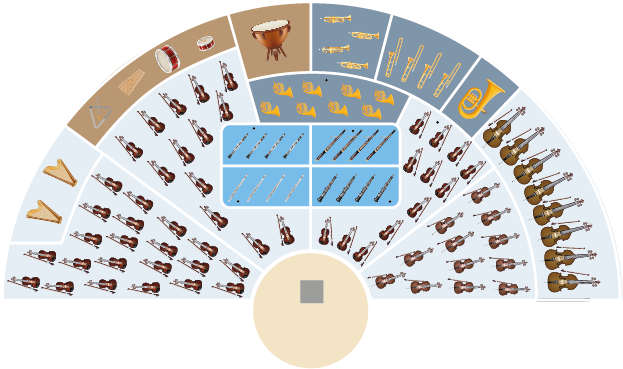
This section of the exam is divided into two parts! For this first part you should know the following:
- The instruments of the orchestra, including the members of the string family, the woodwind family, the brass family and the percussion family. You should have an understanding of how each of these instruments are played.
- Specific to abrsm grade 5 music theory you should have an understanding of the harp, the piccolo, the cor anglais, the tubular bells, xylophone, marimba, glockenspiel, vibraphone, tambourine, castanets, tam tam, triangle and the celesta!
- You should understand which of these instruments are transposing and non transposing. As well as understanding which percussion instruments have a definite pitch or a non definite pitch.
- You should understand what the different voice types are (Soprano, Alto, Tenor and Bass) and what the ranges of these different voices are.
- Lastly, you should know the additional voice types.These are the mezzo soprano and the baritone.
Terms, signs and instruments: Ornamentation
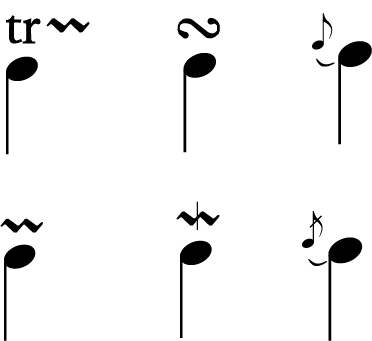
Now let’s look at what the second section of terms, signs and instruments within abrsm grade 5 music theory includes! Within this section you should understand:
- The different ornaments such as the trill, upper and lower mordent, turn, acciaccatura and the appoggiatura!
- Understand your Italian, French and German musical terms. A full free list of these can be found here.
- Understand the performance directions associated with how to play different instruments such as the piano, clarinet etc.
A complete list of Grade 5 Performance Directions can be found here.
Music in context
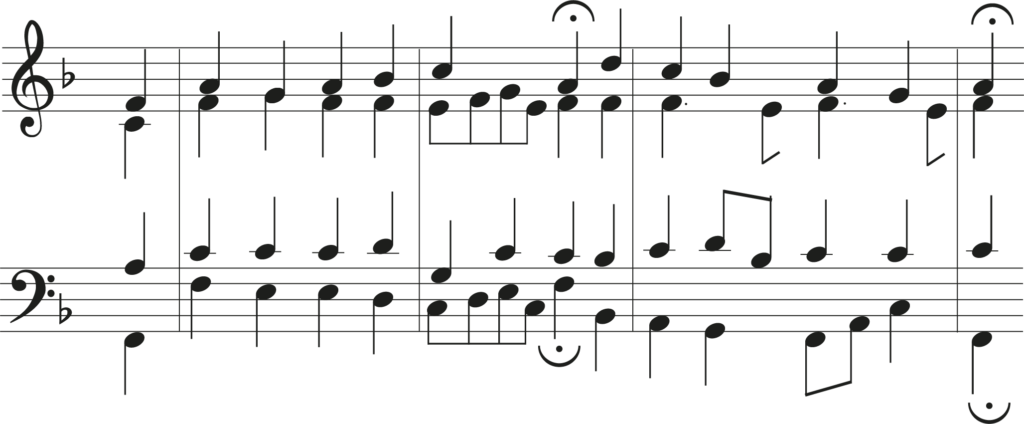
This is the final section of the exam and is focused on putting everything you have learnt together.
Within this section you will be asked to answer questions that involve putting the topics you have learnt earlier in the book, into context! You should be able to look at different pieces of music and put your music theory skills together!
To find out more about the ABRSM exams then do make sure to check out their website here!
Now let’s have a brief look at the exam format you will encounter in this exam.
new grade 5 music Theory exam features

The Grade 5 music theory exam has gone online in response to the pandemic. This means that exams can now be taken in the comfort of your own home, but there are a few restrictions!
Students need to ensure that they have a computer with a webcam for this exam. Having the webcam there allows the exam to be recorded and watched at a later date by an examiner to ensure no cheating took place during the exam. The exam is not watched live.
Whilst doing the exam there is a special type of software that can monitor if you have any other apps or webpages open during the exam! You can check this out on the ABRSM website for more information.
To know more about all of these features and requirements, make sure to look at the abrsm website for more detail and a way to check your system before doing the exam.
At the start of the exam students will be expected to show a form of ID to prove identity but will also be required to scan the room with the webcam. This is to ensure that there are no notebooks, worksheets or keyboards in the room before you start! Remember if you have any of these in the room you may be tempted to look!
When taking the exam you can simply be in the room yourself or you are allowed to have a responsible adult in the room to assist you with all of the set up required before this exam. Please note, they cannot help you to answer the questions!
You ARE still allowed some scrap paper in the exam, this can be plain or manuscript but the only difference now is that you are required to destroy the paper in front of the camera. Usually by simply ripping it up!
When doing the exam, you will know how much time you have left by looking in the top right hand corner of the screen as here will be displayed countdown timer. As you know, some people do finish this exam early and this is still possible with this online exam, you simply click the ‘end test’ button which is also located in the top right!
As you can see, although this exam is now online it is by no means any easier!
It is also worth noting that the exam can now be taken monthly and there are now not any specific termly dates where you need to take the exam. The fee for the exam has however been kept the same!
more information
I hope this has given you a nice overview of what to expect with this new associated board of the royal schools of music online music theory.
Our website provides many free resources to help you progress through the grade 5 music theory course. The teaching of grade 5 music theory course is extremely important if you are to achieve a pass and here at music theory foundations we are passionate about building up your knowledge and arming you with the resources to achieve!
FAQs
Can you earn UCAS points from Grade 5 Music Theory?
- The short answer is ‘no’ you cannot, but it can be useful as a stepping stone to higher grade where you can. More information can be found in our article on Grade 5 and UCAS points.
Should I do practice paper?
- Practice papers can be really useful to hone your skills where you are nearer to your exam. We have a free Grade 5 Practice Paper to download too.
Can I buy a book of Grade 5 Music Theory?
- There are a few good books you can purchase. We have a guide to Grade 5 Music Theory Book here.
